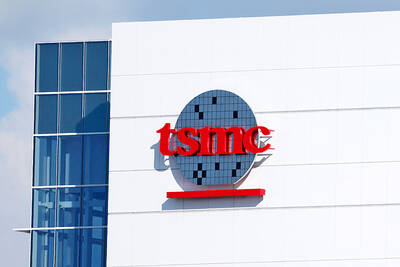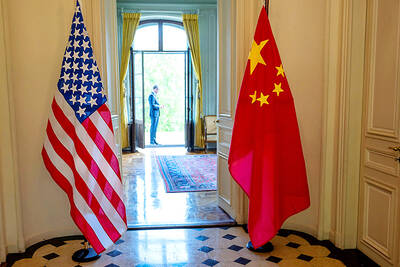Contract electronics manufacturer Wistron Corp (緯創) has not been chosen to assemble the trio of new iPhones set to be launched later this year, Fubon Securities Co’s (富邦證券) survey of Apple Inc’s supply chain showed.
Following setbacks in production yield rates in March, the US technology giant has ruled out Wistron and tapped Hon Hai Precision Industry Co (鴻海精密) and Pegatron Corp (和碩) to assemble the new models, the Chinese-language Apple Daily quoted Fubon Securities analyst Arthur Liao (廖顯毅) as saying.
Hon Hai has been selected to assemble the bulk of the new iPhones, including all of the premium 5.8-inch OLED model and 90 percent of the 6.5-inch OLED phones, as well as 75 percent of the 6.1-inch LCD model, with the remainder given to Pegatron, the report said.
The lower-priced LCD model is to be pivotal in determining market reception for Apple’s smartphone lineup, Liao said, adding that a total of about 83 million units are to be ordered.
While the US$999 starting price tag for last year’s iPhone X drew criticism, Liao said that the 6.1-inch LCD model would be priced at about US$799, lower than the NT$28,900 price for the 5.5-inch iPhone 8 Plus listed on Apple’s Web site.
The budget 6.1-inch model would have nearly all of the same materials as the iPhone 8 Plus, and would cost about US$275, Liao said.
While a 3D sensing module and a bigger display would add US$20 and US$5 to the production cost of the LCD model respectively, its main rear camera would be US$15 cheaper than that of the iPhone 8 Plus, Liao said.
In addition, the new model’s LCD display would not include pressure-sensitivity features, saving US$10 and canceling out the difference in cost, he said.
Meanwhile, local media have reported that Wistron has begun mass production of Apple’s older iPhone 6 series at one of its production plants in India to meet domestic demand there.

Real estate agent and property developer JSL Construction & Development Co (愛山林) led the average compensation rankings among companies listed on the Taiwan Stock Exchange (TWSE) last year, while contract chipmaker Taiwan Semiconductor Manufacturing Co (TSMC, 台積電) finished 14th. JSL Construction paid its employees total average compensation of NT$4.78 million (US$159,701), down 13.5 percent from a year earlier, but still ahead of the most profitable listed tech giants, including TSMC, TWSE data showed. Last year, the average compensation (which includes salary, overtime, bonuses and allowances) paid by TSMC rose 21.6 percent to reach about NT$3.33 million, lifting its ranking by 10 notches

Popular vape brands such as Geek Bar might get more expensive in the US — if you can find them at all. Shipments of vapes from China to the US ground to a near halt last month from a year ago, official data showed, hit by US President Donald Trump’s tariffs and a crackdown on unauthorized e-cigarettes in the world’s biggest market for smoking alternatives. That includes Geek Bar, a brand of flavored vapes that is not authorized to sell in the US, but which had been widely available due to porous import controls. One retailer, who asked not to be named, because

SEASONAL WEAKNESS: The combined revenue of the top 10 foundries fell 5.4%, but rush orders and China’s subsidies partially offset slowing demand Taiwan Semiconductor Manufacturing Co (TSMC, 台積電) further solidified its dominance in the global wafer foundry business in the first quarter of this year, remaining far ahead of its closest rival, Samsung Electronics Co, TrendForce Corp (集邦科技) said yesterday. TSMC posted US$25.52 billion in sales in the January-to-March period, down 5 percent from the previous quarter, but its market share rose from 67.1 percent the previous quarter to 67.6 percent, TrendForce said in a report. While smartphone-related wafer shipments declined in the first quarter due to seasonal factors, solid demand for artificial intelligence (AI) and high-performance computing (HPC) devices and urgent TV-related orders

MINERAL DIPLOMACY: The Chinese commerce ministry said it approved applications for the export of rare earths in a move that could help ease US-China trade tensions Chinese Vice Premier He Lifeng (何立峰) is today to meet a US delegation for talks in the UK, Beijing announced on Saturday amid a fragile truce in the trade dispute between the two powers. He is to visit the UK from yesterday to Friday at the invitation of the British government, the Chinese Ministry of Foreign Affairs said in a statement. He and US representatives are to cochair the first meeting of the US-China economic and trade consultation mechanism, it said. US President Donald Trump on Friday announced that a new round of trade talks with China would start in London beginning today,